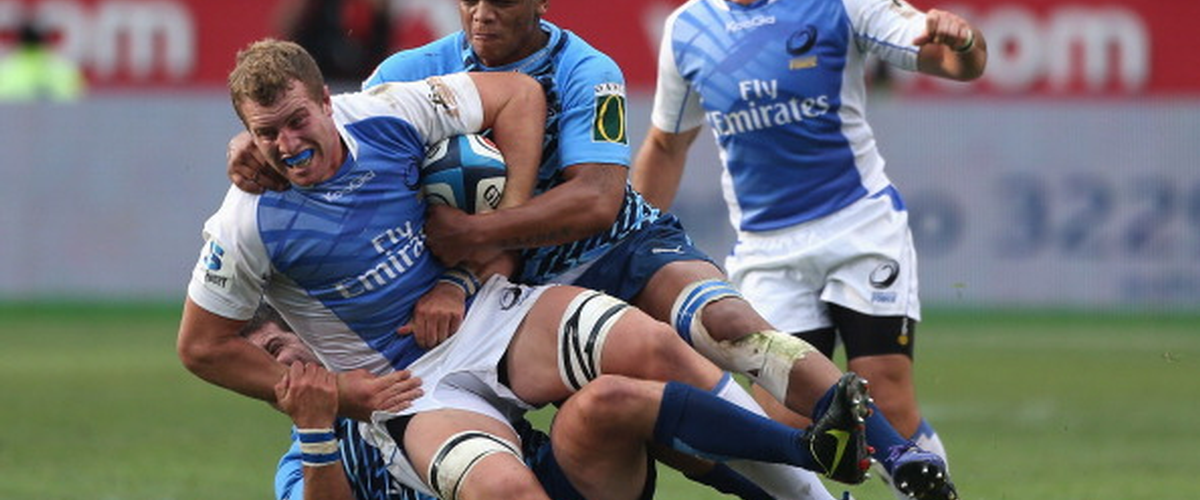We bring you the second of a four part series focusing on specific game measures for Super Rugby, that is, how scrums, tackles, work on areas and the referee team have been tracking so far in 2013 Super Rugby, today we bring you the tackle area.
With teams setting record numbers in regards to ruck retention, and the success rate of tackles made dropping as the season progressing, the most pleasing aspect of the tackle area so far this year was the decreased amount of confusion at the tackle area.
SANZAR Game Manager Lyndon Bray said this was indicative of a clear work-on for the Super Rugby referee’s team, where there were objectives that the group were following to ensure that any trends (such as consistent penalties at the ruck during a match) were obvious for the fans.
.png)
"The good thing is the general public and Media have been commenting that they find the tackle and ruck phase less confusing than previous years," Bray said, in reference to an area which is the crucible of our game, yet is still misunderstood by many (click here to see 2011 World Cup Final and Super Rugby referee Craig Joubert’s explanation on a breakdown)
With Bray and the referees spending a significant amount of time together pre-season looking at season goals, and continually working together throughout the competition, patterns emerged to make it easier to follow the game via the contest at the ruck area.
Players were working well within these parameters, while as always there was a focus to ensure that individuals were rewarded, whether it be defenders making it a fair and legal contest, or attacking playing successfully driving over the tackled player to keep the phases mounting.
"I think the main reason for this (better transparency at the ruck) is that the referees are focusing on common objectives at these phases and we are seeing a common trend of penalties that we as spectators can follow,” he said.
“We are all getting used to a defender who clearly beats the ruck and should get rewarded for that and we also recognise when a defender has been successfully cleaned out by the attackers, and therefore we play on with continuity to the ball carrier."
.png)
Overall, most teams ruck retention rate was at phenomenal levels, with Super Rugby’s focus long the continuity of play through attack, with all fifteen teams well above 90% with a small spread – The Crusaders are at number one with 97% ruck success, with the Rebels 15th at 93%.
Yet despite this there was a high level of turnovers while teams, despite their accuracy in retaining possession, were still highly susceptible to losing the ball at the tackle area.
"Yes, it is quite noticeable that some teams in this year's competition have become extremely adept at hunting turnovers," Bray said.
In Round Thirteen alone there were 143 turnovers (admittedly not all of them specifically forced by opposition), while 34 times in total teams lost possession at the ruck, showing how some sides are devising specific tactics to give themselves the best chance of snaffling possession.
"The Brumbies have made an art form of getting a 'man on his feet' over the ball as early as possible after they make a tackle,” Bray noted.
“Which puts huge pressure on the opposition to protect their ball carrier and try to clean out as quickly as possible."
Trends were clearly changing despite team’s best intentions, with the notable downward curve in performance being side’s efficiency in tackle success, but this was likely down to evolving firepower by the marquee attacking outfits or the fact that it becomes a little bit harder to tackle a player fourteen rounds into a season.
.png)
It is of further interest to note that the sliding tackle success, with no team having an efficiency better than 90%, is not coming from missed tackles, but rather increasing numbers of line breaks and beaten defenders – again showing that some teams are becoming more proficient attackers.
Still, the one mantra that was holding firm was that the coalface was still the primary engagement area for back row forwards, with the eight top tacklers in the competition all wearing numbers 6, 7 or 8 on their jerseys.
.png)
In case you forgot...
LAWS OF THE GAME - The Tackle Area
15.1 Where can a tackle take place
A tackle can only take place in the field of play.
15.2 When a tackle cannot take place
When the ball carrier is held by one opponent and a team-mate of the ball carrier binds on to that ball carrier, a maul has been formed and a tackle cannot take place.
15.3 Brought to the ground defined
(a) If the ball carrier has one knee or both knees on the ground, that player has been ‘brought to ground’.
(b) If the ball carrier is sitting on the ground, or on top of another player on the ground the ball carrier has been ‘brought to ground’.
15.4 The tackler
(a) When a player tackles an opponent and they both go to ground, the tackler must immediately release the tackled player.
Sanction: Penalty kick
(b) The tackler must immediately get up or move away from the tackled player and from the ball at once.
Sanction: Penalty kick
(c) The tackler must get up before playing the ball and then may play the ball from any direction.
Sanction: Penalty kick
15.5 The tackled player
(a) A tackled player must not lie on, over, or near the ball to prevent opponents from gaining possession of it, and must try to make the ball available immediately so that play can continue.
Sanction: Penalty kick
(b) A tackled player must immediately pass the ball or release it. That player must also get up or move away from it at once.
Sanction: Penalty kick
(c) A tackled player may release the ball by putting it on the ground in any direction, provided this is done immediately.
Sanction: Penalty kick
(d) A tackled player may release the ball by pushing it along the ground in any direction except forward, provided this is done immediately.
Sanction: Penalty kick
(e) If opposition players who are on their feet attempt to play the ball, the tackled player must release the ball.
Sanction: Penalty kick
Tackled player must release the ball immediately
(f) If a tackled player’s momentum carries the player into the in-goal, the player can score a try or make a touch down.
(g) If a player is tackled near the goal line, that player may immediately reach out and ground the ball on or over the goal line to score a try or make a touch down.
A player tackled near the goal line can reach out and ground the ball to score a try
15.6 Other players
(a) After a tackle, all other players must be on their feet when they play the ball. Players are on their feet if no other part of their body is supported by the ground or players on the ground.
Sanction: Penalty kick
Exception: Ball goes into the in-goal. After a tackle near the goal line, if the ball has been released and has gone into the in-goal any player, including a player on the ground, may ground the ball.
After a tackle all of the players must be on their feet while they play the ball
(b) After a tackle any players on their feet may attempt to gain possession by taking the ball from the ball carrier’s possession.
(c) Players in opposition to the ball carrier who remain on their feet who bring the ball carrier to ground so that the player is tackled must release the ball and the ball carrier. Those players may then play the ball providing they are on their feet and do so from behind the ball and from directly behind the tackled player or a tackler closest to those players’ goal line.
Sanction: Penalty kick
(d) At a tackle or near to a tackle, other players who play the ball must do so from behind the ball and from directly behind the tackled player or the tackler closest to those players’ goal line.
Sanction: Penalty kick
(e) Any player who gains possession of the ball at the tackle must play the ball immediately by moving away or passing or kicking the ball.
Sanction: Penalty kick
(f) Any player who first gains possession of the ball must not go to the ground at the tackle or near to it unless tackled by an opposition player.
Sanction: Penalty kick
(g) Any player who first gains possession of the ball at the tackle or near to it may be tackled by an opposition player providing that player does so from behind the ball and from directly behind the tackled player or the tackler closest to that player’s goal line.
Sanction: Penalty kick
(h) After a tackle, any player lying on the ground must not prevent an opponent from getting possession of the ball.
Sanction: Penalty kick
(i) After a tackle, any player on the ground must not tackle an opponent or try to tackle an opponent.
Sanction: Penalty kick
(j) When a tackled player reaches out to ground the ball on or over the goal line to score a try, an opponent may pull the ball from the player’s possession, but must not kick or attempt to kick the ball.
Sanction: Penalty kick





